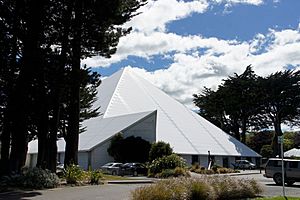Southland Museum and Art Gallery facts for kids
 |
|
 |
|
| Established | 1912 |
|---|---|
| Location | Gala Street, Invercargill, New Zealand |
The Southland Museum and Art Gallery Niho o te Taniwha was a special place in Invercargill, New Zealand. Its full name, "Niho o te Taniwha," means "the tooth of the taniwha" in the Māori language. This museum was the biggest cultural and heritage center in the Southland area.
It held many different collections, including art, history, and natural history from the region. The museum was famous for its unique pyramid-shaped building, which was built in 1990. This new building was constructed around the original museum, which opened in 1942. The museum closed its doors in April 2018 because of safety concerns about earthquakes.
Contents
What Made the Museum Special?
The Pyramid Building
The pyramid-shaped building, finished in 1990, was quite impressive. It was the largest pyramid in the Southern Hemisphere. This huge building covered an area of 5,000 square meters. It measured 45 by 52 meters wide and stood 27 meters tall.
The Observatory
The museum also had an observatory, which was the only public one in Southland. Members of the Southland Astronomical Society used to run it. School groups often visited to learn about stars and planets.
Amazing Tuatara
One of the most popular parts of the museum was the tuatarium. This special area was built in 1974 and made even bigger in 1990. It was home to over 50 live tuatara, from tiny babies to the very famous Henry.
Henry joined the museum in 1970 and is believed to have been born around 1900. He holds the world record for being the tuatara kept longest in captivity. Henry even became a father for the first time in 2009! The tuatara at the museum regularly laid eggs every two years. A new roof that let in special ultraviolet light helped almost all the eggs hatch and all the baby tuatara survive.
Interesting Galleries
The museum had several galleries that showed different parts of Southland's history and nature.
Māori Culture Gallery
The Māori Gallery focused on the daily lives of Māori people in Murihiku (the Southland area) long ago. Visitors could learn how they made tools like adzes, fished using bone and stone lures, and played musical instruments.
Natural History Gallery
This gallery displayed rare and endangered animals, such as the kākāpō and kiwi. It also showed fossil bones of extinct birds like the moa. You could also learn about geology and sea life in this section.
Beyond the Roaring 40's Gallery
This gallery explored the unique and special environment of the subantarctic islands. It was created with help from both the museum and the Department of Conservation.
Fossil Forest Reconstruction
Outside the museum, there was a reconstruction of a fossil forest. This was inspired by the real petrified wood forest at Curio Bay on Southland's coast. Visitors could walk among ancient tree stumps and sections of wood that were 130 million years old. There were also two-meter tall bronze tuatara sculptures.
Art Collections
The art galleries regularly showed both modern and historical art exhibitions. These included traveling shows and works from the museum's own collections. Many pieces focused on art from the Southland region, including Stewart Island and the Subantarctic Islands.
The museum had a large collection of art, photographs, ceramics, and crafts. A very important painting was by William Hodges, called "A Maori before a waterfall in Dusky Bay" (1773). Another special item was Te Mauri, a large greenstone (pounamu) boulder. This boulder traveled to America as part of the famous Te Maori Exhibition in 1984.
History of the Museum
The Southland Museum and Art Gallery started from a small collection. It was first shown in 1869 by Andrew McKenzie in his "Scotch Pie House and Museum" in Invercargill. The collection was bought by the Invercargill Athenaeum in 1876. By 1912, it was moved to the Southland Technical College.
The Southland Museum officially opened at the Southland Technical College on September 4, 1912. J Crosby Smith was the first Curator and President of the Southland Naturalist Society.
The original museum building at the entrance to Queen's Park was built as a memorial for New Zealand's Centennial. It opened in 1942. Over the years, many parts were added. An art gallery opened in 1960, and the Southland Astronomical Society Observatory was added in 1972. The building was expanded in 1977 and 1984, leading to a big redevelopment in 1990.
The 1990 redevelopment was a major change. It enclosed the older building inside the 27-meter tall pyramid. This project also added special art gallery spaces and the Tuatarium Gallery for the tuatara breeding program.
Museum Closure and Future
The Invercargill City Council announced on April 9, 2018, that the Southland Museum and Art Gallery building would close. This was because it was not safe in case of an earthquake. The building was found to be less than 34% of the required earthquake safety standard for new buildings.
After the closure, the museum staff was reduced. Large items from the collection were moved from the upper floors. The collection was then prepared to be moved to a storage facility.
Planning is currently underway for a new museum building to open in the future. In the meantime, a temporary space called Te Waka Tuia Art + Museum opened in 2020. This space, located on Kelvin Place, is a partnership between the Southland Museum and Art Gallery and the Invercargill Public Art Gallery. It shows parts of their collections and hosts events.
Demolition of the old pyramid building started in May 2024. However, it was paused when four baby tuatara were found living in the former enclosure. They were likely missed as eggs when the adult tuatara were moved in February 2023.
See also




